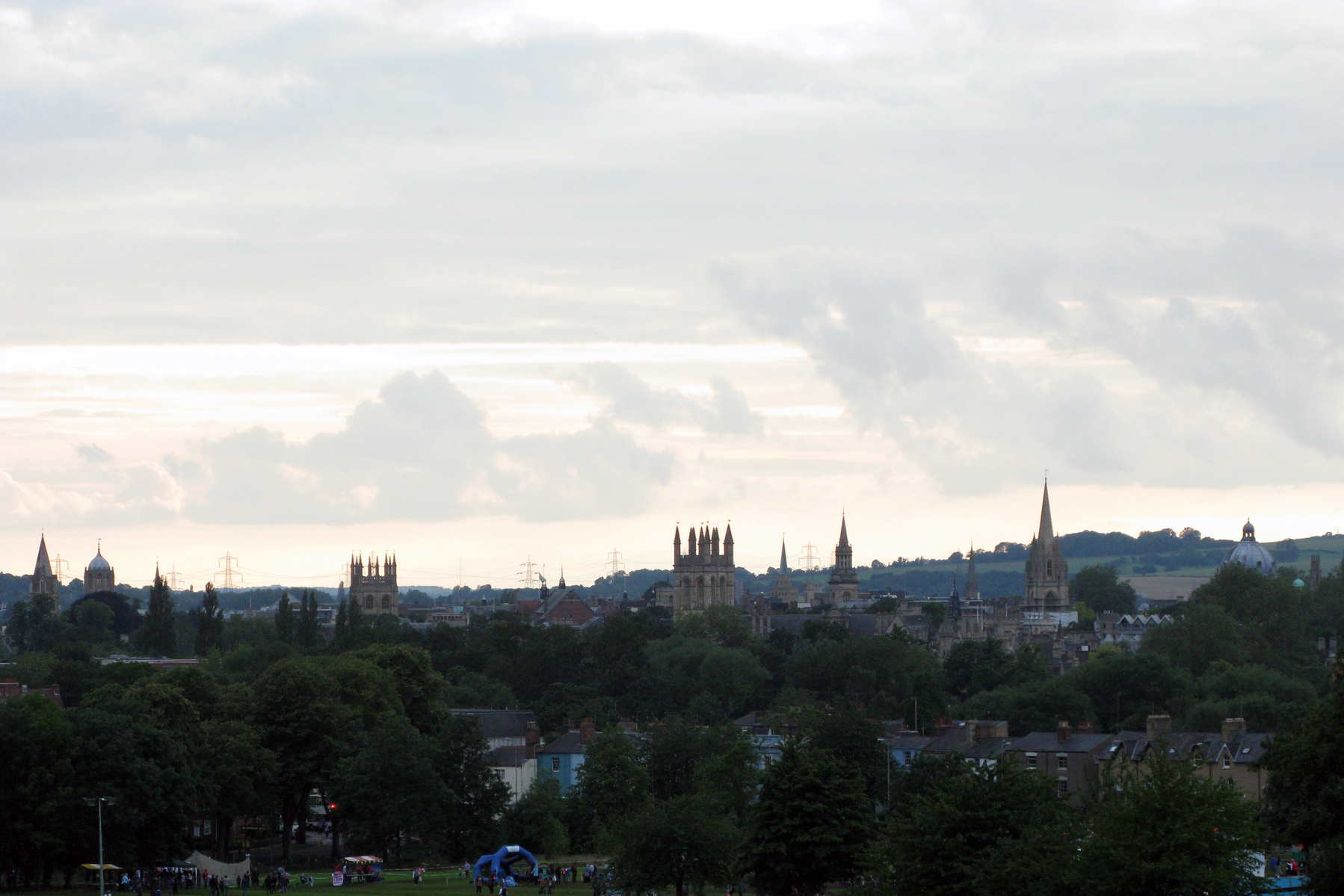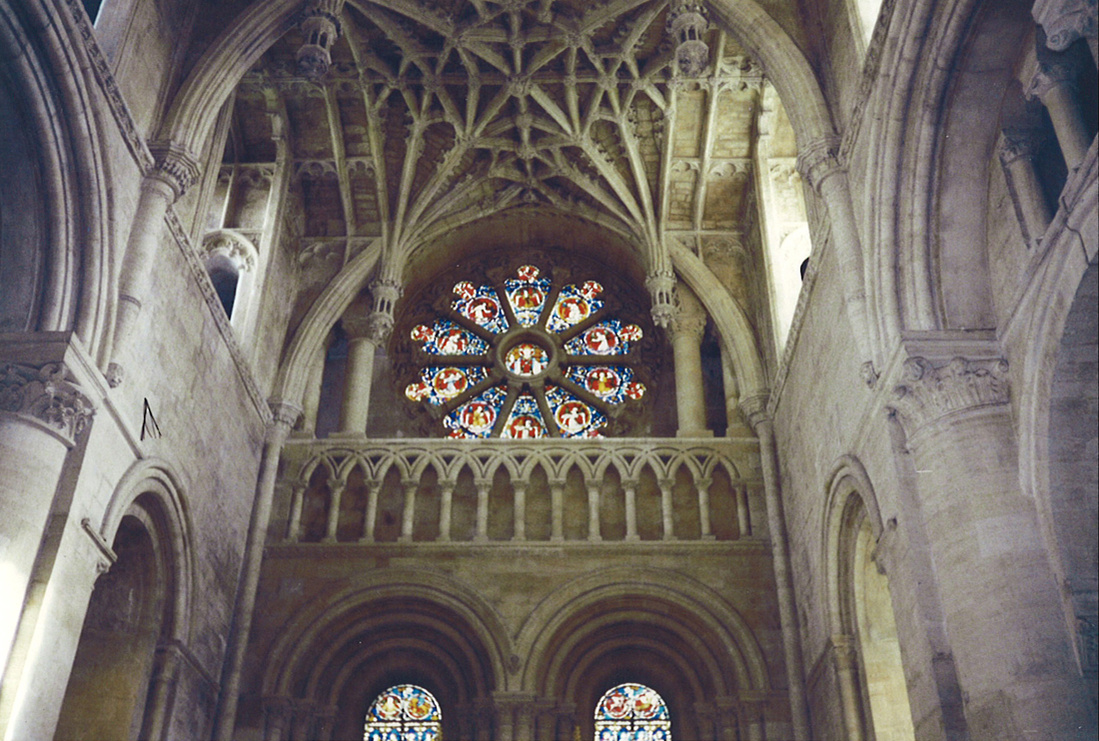In spires: The influence of Oxford’s architecture on my artistic practice
January 5, 2023I am an artist who makes art about architecture. Having grown up in Oxford, the architecture of the various colleges, chapels and churches that make up the majority of the city centre feels like home to me. We moved out of the city when I was seven, but I returned as an undergraduate to study at the Ruskin School of Art. When I began my studies, I was primarily making abstract, geometric paintings, but gradually architectural forms began cropping up again and again in my work.
I read an essay by the artist and writer Robert Morris during my first term as an undergraduate. In it, Morris argued that when you look at an object, you surround it, but when you look at architectural space, you are surrounded by it.(1) There are some exceptions to this, but in general I think the distinction makes sense. This idea of being surrounded by architectural space reminded me of what walking through Oxford felt like, although when walking you are not so much surrounded by the architectural space of a particular building but of the city as a whole.
Oxford is known for its architecture, the ‘dreaming spires’ of Matthew Arnold’s poem Thyrsis.(2) What are they dreaming of, exactly? Do Oxford’s spires dream of cap and gown-clad sheep? Joking aside, there is something wistful, maybe even metaphysical, about the architecture of “that sweet city” that has been home and haven to so many brilliant minds over the centuries.
I think that much of this sense of wistfulness stems from the fact that the majority of these spires that compose the skyline of Oxford are the spires of churches, chapels, and of course Christchurch Cathedral. Church buildings are designed with spires in order to be seen from a distance, gathering people to worship. However, the church spire has a more complex visual function than that of a simple landmark. The point of the spire, reaching up above the cluster of regular-height city buildings, directs the viewer’s gaze to the heavens. When you look at a spire, your eyes follow it upwards until you are looking at the sky above it. The reaching point of the church spire bridges the gap between city below and sky above, visually bringing heaven down to touch earth.(3) In this the architecture of church spires communicates the message at the heart of the Christian faith: that the God of heaven came down to earth to bridge the gap between humankind and God.
Whether you would describe yourself as religious or not, there is something that happens as we cross the threshold into one of these chapels or cathedrals. We get a sense of wonder, experience the beauty of the architecture, the lighting, a sense of something bigger than ourselves that has stood the test of time, a sense of something too abstract for words. Much of my art practice is an investigation into this effect that ecclesiastical architecture has on the viewer, what we might call ‘the phenomenology of sacred space’. There’s something we can’t quite put into words about the weight, the gravity of walking into a space like that.
To put it in a nutshell, phenomenology is the idea that we don’t just experience the world on an intellectual level, but on a physical level as well. We’re not brains in jars; we have bodies that experience the world in three dimensions, that can see, and touch, and hear, and smell, and taste. In contrast with René Descartes’ “I think therefore I am”(4) - my understanding of phenomenology is more like ‘I experience the world with my body and my mind and everything that makes me who I am’ - therefore I am. I think our experience of space, especially architectural space, consists of the experience of our bodies as well as our brains. You don’t get that from, for example, walking around a space online via Google street view. (Believe me, in the 2020 Coronavirus lockdown I tried.) You have to be physically in the space, surrounded by its architecture, breathing in its air.
But what happens when you isolate the individual architectural elements from a particular building, and place these isolated forms in a different context? Do they still have this physical presence when removed from their surroundings? I am currently investigating this question through my art practice. Many of my sculptures are inspired by a particular architectural detail, usually a part of a church or cathedral, often a spire or a stained glass window. I take these architectural shapes, part of the fabric of the building, and pull them from their original contexts, making individual sculptures of these forms that once were part of a greater whole. Many of these sculptures are themselves wall-based, meaning that through the sculptural process the original form goes from being part of a building to hanging on the wall of a different building, becoming portable. My hope is that something of the architectural presence of the original building is captured in these sculptures, that can then be imparted to the new space in which they hang. They are made in the image of the building they came from, but can carry that image beyond that building’s walls.
This dichotomy between the portability of sculpture and the permanence of architecture is a central concept of my artistic practice. It reminds me of Robert Morris’ we surround/we are surrounded distinction between sculpture and architecture that I touched on earlier. How do we engage with permanent architectural structures in the contemporary world, where we are constantly moving from place to place? When we are surrounded by new and unfamiliar space, what can we choose to bring with us, to surround us, ground us and remind us of home?
For many people the city of Oxford represents that first ‘home away from home’. Many come here to study, many looking for work. It is home to over 33,000 university students who come from all over the world to study in the city.(5) Compared to the 54 other largest cities in England, Oxford has the highest number of students, with students making up 24% of the adult population of the city.(6) This high number of students, who spend their university years here and then often return home, contributes to Oxford’s high population turnover, which at 26%, is once again the highest out of cities in England.(7) If we’re looking for examples of people constantly travelling from place to place in our globally connected society, Oxford is the transient city par excellence.
What comprises a city: the buildings or the people? For all the transience of its population, Oxford’s dreaming spires remain constant, immutable, abiding. As we are surrounded by the city, as we dwell here for a time, we begin to call its architecture home. However fleeting our stay might be, the city remembers us. As we walk the city’s streets, we walk in the footsteps of those who have gone before us, joined through centuries of history, experiencing a shared architecture. As passers-by, we play a fleeting onstage role in the dreaming of the spires.
Sources
(1) “In perceiving an object, one occupies a separate space - one’s own space. In perceiving architectural space, one’s own space is not separate but coexistent with what is perceived. In the first case one surrounds; in the second, one is surrounded. This has been an enduring polarity between sculptural and architectural experience.”
Morris, R. (1995) “The Present Tense of Space,” in Continuous Project Altered Daily: The writings of Robert Morris. Cambridge, MA: MIT Press. Available at: http://koperseminar.pbworks.com/f/Robert+Morris+Present+Tense.pdf (Accessed: December 16, 2022).
(2) Arnold, M. (1865) Thyrsis: A Monody to Commemorate the Author’s Friend, Arthur Hugh Clough, Poetry foundation. Poetry Foundation.
Available at: https://www.poetryfoundation.org/poems/43608/thyrsis-a-monody-to-commemorate-the-authors-friend-arthur-hugh-clough (Accessed: December 16, 2022).
(3) Fulton, C. (2018) Dwelling with the divine: towards a phenomenology of sacred space, Arkittekt.com. Dissertation.
Available at: https://www.arkittekt.com/read/dwelling-with-the-divine-towards-a-phenomenology-of-sacred-space (Accessed: January 5, 2023).
(4) Descartes, R. and McLean, I. (2006) “A Discourse on the Method: Part Four,” in A discourse on the method of correctly conducting one’s reason and seeking truth in the Sciences. Oxford: Oxford Univ. Press.
Available at:
https://rauterberg.employee.id.tue.nl/lecturenotes/DDM110%20CAS/Descartes-1637%20Discourse%20on%20Method.pdf (Accessed: December 16, 2022).
(5) https://www.oxford.gov.uk/info/20131/population/459/oxfords_population (Accessed: December 16, 2022).
(6) https://www.oxford.gov.uk/downloads/file/5021/oxford_profile_2018 (Accessed: December 16, 2022).
(7) Ibid.




